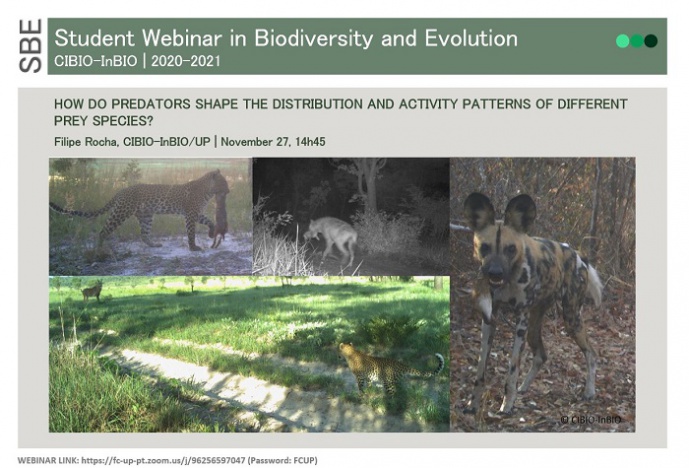How do predators shape the distribution and activity patterns of different prey species?

STUDENT WEBINAR IN BIODIVERSITY AND EVOLUTION
Prey species constantly need to weight the trade-off between the inevitability of assessing key resources and risk of being killed. These spatial and temporal components of perceived predation risk and preemptive behavior are accommodated in modern ecological theory, as landscape of fear and risk allocation hypotheses. Our goal is to investigate the spatiotemporal foraging strategies employed by herbivores, and quantify how they are affected by predation risk and the availability of required resources.
We collected camera trapping data from 161 cameras deployed in Bicuar National Park and Cuatir Private Reserve (Angola), between June 2017 and November 2019. Prey species were selected according to their susceptibility to predation extant predators. We fitted two-species co-abundance models under Royle-Nichols parametrization to each predator-prey pair to estimate local abundance of the prey species conditional on the predator abundance. We included distance to water and proportion shrub/grass cover as state covariates. Fine-scale spatiotemporal interactions were investigated using a time-to-encounter approach.
Our preliminary results suggest the most stalked prey species are common duiker and steenbok, which are simultaneously the most abundant and widely distributed. These prevent them to spatially segregate from predators, but they appear to avoid areas recently visited by them. However, at lower densities, these species distribution is constrained by ambush predators. Medium size ungulates, such as greater kudu and warthogs, have their distribution negatively affected by cursorial predators, which is likely a preventive behaviour since both groups have activity peaks during the day.
The result also suggests that bushpig does not suffer much predation pressure in our study sites, since it does not segregate from predators, neither spatially nor temporally.
Overall, our results are supportive that preferred prey species adapt their spatiotemporal activity patterns in response to predators’ activity and spatial distribution. Conversely, less intensively predated species appear to retain optimized resource-aquisition routines, likely because they perceive lower risk.